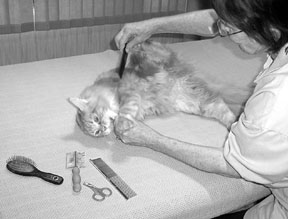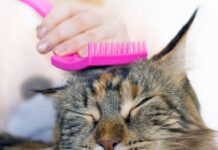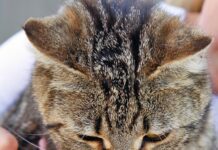
288
Its that time again: You anticipate the chasing, the struggle, the nipping, the yowling. Its grooming time and both you and your cat are dreading it. But you feel guilty about those mats in your cats beautiful fur, and it certainly isnt healthy for him.
Some cats love to be groomed; others tolerate it and others truly loathe it. If your cat runs at the sight of the half-hidden comb in your hand, there are some things you can do to make the process easier. Your cat may never relish having his fur untangled, but he may learn to sit through a grooming session without becoming wild.
Why Its So Important
You may wonder if regular grooming is worth the hassle. It is, say experts, because theres a lot more at stake than just your cats looks. Brushing and combing helps to stimulate circulation in your cats skin, and removes loose hair that will otherwise become hairballs or find its way onto your carpet and clothes.
Grooming also prevents matting that not only looks and feels awful to you, but can also irritate your cats skin, leading to itching and infection. And while you groom your cat, you can check for ticks or fleas or any other physical changes, such as lumps. If you and your cat get to the point where grooming is not troublesome, it gives you some time to spend with your cat which he may actually end up enjoying.
Long-haired breeds need regular grooming. Persians and other breeds with pushed-in noses often have a hard time cleaning themselves, says Marie Heffron, a groomer at Four Paws Pet Grooming in Manilus, New York. The loose dead hair binds itself to the growing hair, causing knots and mats under the top layers of fur.
But short-haired breeds also need to be groomed. Short coats can get matted, especially if they are very thick. And some cats are just not very good at grooming themselves, so you have to help them out.
The Easiest Way
Its best to get your cat accustomed to grooming by starting when he is a kitten. But if youve got a grown cat on your hands, theres still a chance. Start by approaching your cat when she is in a relaxed mood. Begin by petting her, stroking her and speaking to her gently, suggests Ms. Heffron. You may want to first trim your cats nails so she wont scratch you if she becomes irritated. Then start combing her with your fingers. You may even be able to gently untangle some knots this way.
Next, bring out the comb and start gently combing your cat, getting him accustomed to the comb itself. You can pet and comb him at the same time.
Consider a grooming partner if your cat really starts resisting: One partner can hold the cat by the scruff of the neck and hold the paws, while the other groomer starts combing.
The point is to remove knots without causing pain to your cat. Big knots and matted fur are close to your cats skin. Tugging at them forcefully with your fingers or the comb can be very painful, causing irritation to your cats skin – and making your cat resist being groomed in the future. Whatever you do, says Ms. Heffron, dont cut your cats knots out with scissors or other sharp instruments. Cats skin is very thin and you can easily cut your cat, leaving a gaping hole that requires stitches.
Alas, there are some cats that will just not let you groom them. In this case, says Ms. Heffron, bring your cat to a professional groomer who can remove the knots and mats. Sometimes, a cat is so matted that the groomer must shave the mats off to safely remove them.
Right after you bring your cat home from the groomer, take a few minutes to comb your cat, says Ms. Heffron. And do it regularly – before knots get established. This way your cat will get used to grooming without pain because there are no knots yet to contend with. Cats that hate grooming hate the pain associated with it, says Ms. Heffron.
After grooming, you should reward your cat for sitting through all this work. A special treat is good, and so is some quality playtime. Do this a few times and your cat may become much more agreeable during grooming sessions in anticipation of a reward.
Get the Right Tools
The most important tool you need to remove knots is a hard metal comb, which you can purchase from a pet supply store, says groomer Marie Heffron. A slicker brush is also useful. While brushing your cat will make the outer fur look very nice, you really need the comb to get down to the bottom layers of the fur to prevent and remove tangles and knots.



